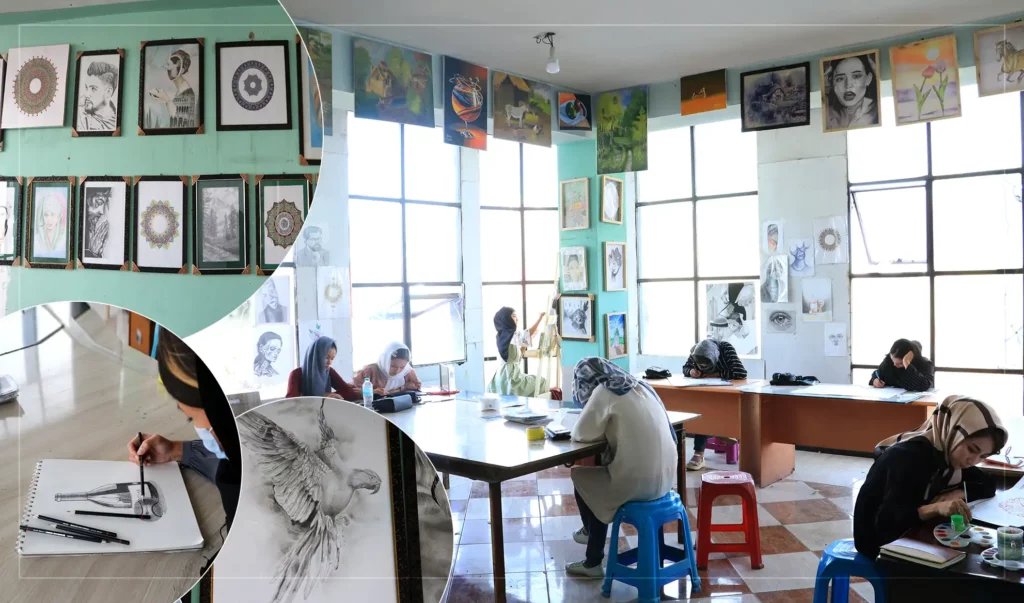KABUL (Pajhwok): A number of calligraphers and painters in Kabul complain the use of technology is affecting their business, forcing a sharp cut in orders from abroad over the past two years.
Pajhwok Afghan News conducted interviews with several heads of calligraphy and painting training centers. They grumbled about their dwindling business and urged the Islamic Emirate to support them by organising exhibitions.
The Ministry of Information and Culture, on the other hand, promised to support the calligraphers and painters.
Calligraphy
In the solar year 1350, Prof. Abdul Hai Habibi wrote a book called “The History of Afghanistan’s Ancient Calligraphy and Writings”. He traced the history of calligraphy in Afghanistan to the prehistoric period.
He hailed Azizuddin Wakili Fofelzaei, Hosseini Khormi, Tamim Raha, Seyyed Mehboobullah Hashemi and Omar Sediq as renowned calligraphers of the country.
Karimullah Rahmani, the owner of “Rahmani Calligraphy and Painting Centre” in Kabul, deplored his stagnating trade.
Having spent many years of his life perfecting this art, he has taught many students over the past decade. “Previously, calligraphy flourished very well, because at that time, handwork was generally considered complementary. In the past, he recalled, there was no printing. Instead, there were large handwritten plates.
With the use of modern technology, the calligraphy trade has suffered; “But our people still have a taste for the art and want calligraphy that began in the Islamic era to continue.”
“Before the political change, we used to receive a lot of foreign orders, but now they have decreased. We used to have orders from clients in Dubai and Saudi Arabia. Today, however, visas for these countries are not easily available. As a result, we cannot arrange exhibitions there.”
Until two years ago, they received most of foreign orders for calligraphed and miniature Quran. Most of such orders came from Saudi Arabia, France and America.
For example, Rahmani said: “We had calligraphed a copy of the Holy Quran and received 100,000 afghanis for our effort, including the miniature and calligraphic panel costs amounting to 40,000 and 30,000 afghanis. We sell a piece of paintings and calligraphy for $100 to $250.”
Rahmani asked the Islamic Emirate of Afghanistan to cooperate with them on boosting sales and exporting their works abroad.
Wall chalking and paintings have become popular in Kabul in recent years, creating work opportunities for calligraphers and painters.
Rahmani said that calligraphy was still useful in terms of plaque writing and wall chalking. Before the fall of the previous regime, this art form was more common.
He sought government support for the calligraphers and painters who are struggling with economic problems.
The interest of youngsters in learning the art has not declined, but burgeoning economic hardships have tamped down the number of students at his educational centre.
According to him, previously 300 males and 100 females were trained in different departments at the centre, but now the numbers has fallen to 200.
Meanwhile, Bashir Ahmad Mastani, who has highly variegated experience in the art of painting and drawing, says he established his calligraphy training centre three years ago.
According to him, there have been no changes in calligraphy and people are still interested in the art. But increasing economic woes are taking a toll on the business. He also demanded support from the caretaker government.
Art of calligraphy
Writers and historians’ cities Hafiz Pakzad, Ghousuddin Rasam and Ghulam Mohammad “Masour” as leading painters of the country.
One of Kabul-based painters explained no restrictions had been imposed on their work after the fall of the previous administration.
However, he said, their sales had slumped and so had the number of students at educational centres due to the ongoing economic crisis in the country.
Previously, he recalled, the importance of painting was highlighted through exhibitions, where their works were marketed. But now few art and painting exhibitions are organised.
Although there were many art lovers, due to economic problems, the number of painting buyers and learners had fallen, he noted.
“So far, the government has not imposed any restrictions on me and I hope it will not. I expect it will provide me help. I do not have the required facilities to train more students.
“Another problem is that the buying and selling of paintings has considerably decreased. Because of cash constraints, people cannot buy even the cheapest art piece,” he commented.
The artist urged the caretaker government to take measures for marketing their works through holding exhibitions.
Registration of calligraphers, painters
Hayatullah Mohajir Farahi, deputy director of broadcasting at the Ministry of Information and Culture, said they were working on a plan to register all calligraphers across the country.
After registering them, the ministry plans to arrange regular meetings with visual artists with a view to addressing their problems.
He added the ministry was doing its bit to cooperate with the calligraphers registered with it.
As of now, specific numbers of painters and calligraphers in the country are not known, because they are not registered. But the ministry has now initiated work on documenting calligraphers.
sa/mud








GET IN TOUCH
NEWSLETTER
SUGGEST A STORY
PAJHWOK MOBILE APP